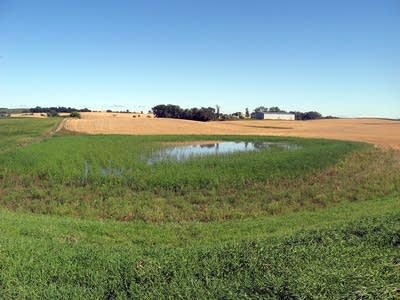Wetlands loss outpacing restoration efforts

State and federal officials are using science to help target areas for wetland restoration as part of the state's 50-year plan to add 2 million acres of waterfowl habitat in the state; however, even though Minnesota is spending millions to restore wetlands, the state is still losing more than it restores.
The western third of Minnesota was once covered with wetlands; hundreds of thousands of small potholes and large marshes.
Now, more than 90 percent are drained.
At the Fergus Falls Office of the U.S. Fish and Wildlife Service, Rex Johnson pointed to a map of what the landscape once looked like.
Create a More Connected Minnesota
MPR News is your trusted resource for the news you need. With your support, MPR News brings accessible, courageous journalism and authentic conversation to everyone - free of paywalls and barriers. Your gift makes a difference.
"This is Swift County. All the red was once wetlands," he said.
A lacy network of red lines covers the map showing thousands of wetlands that were once filled with water.
"Regardless of how you feel about wetlands or wetland drainage, you have to admire the work ethic that went in to draining these wetlands," Johnson said.
These maps are part of the Minnesota restorable wetlands inventory. The project started in 2002, and should be finished by the end of next year. Minnesota will be the only state to have such detailed wetland data.
Rex Johnson said the maps can help state and federal officials identify the best areas for restoring wetlands and grasslands needed by nesting waterfowl. Computer models can compare how ducks will fare on different plots of land.
"If we do this we can actually estimate, by running these models, how many ducklings we are going to get per dollar spent over a 30-year [period]," he said. "So we can reduce it to ducklings per dollar. That's the essence of efficient conservation."

But wetlands aren't just for ducks; they act as filters to improve water quality and help reduce flooding.
Minnesota leads the nation in spending on wetland restoration according to Bill Hunt, who's in charge of federal conservation programs in the state.
Over the past two years, more than 22,000 acres were enrolled in the program at a cost of $74 million. The land is locked into the program forever. Hunt said combining state and federal dollars allowed the program to pay landowners a more competitive price, and more landowners signed up.
Bill Hunt expects similar success next year thanks in part to money from the sales tax increase Minnesota voters approved.

"We're still expecting, even though we have sort of a bad economy, $8 million or $9 million to be allocated," Hunt said. "If that happens and continues to happen we will continue to have I consider the premier wetland restoration on private lands program in the nation."
But Minnesota is still losing wetlands faster than they are restored. A recent study by the Fish and Wildlife Service estimates a net loss of more than 96,000 acres since 1980. Most of the losses are the result of farmers maintaining and improving old ditch networks.
The USFWS says most of the losses were due to maintenance on old farm drainage systems that improved drainage and emptied wetlands that in some cases were first drained decades ago.
Minnesota DNR Wetland Wildlife Program Leader Ray Norrgard said the state has made good progress. More than 80,000 acres of habitat was restored the first two years of the duck plan initiative. But last year, the state took a step backwards when thousands of acres of Conservation Reserve program land was plowed up and put back into crop production.
More than 800,000 acres of CRP could be plowed up and returned to farming over the next five years. It's estimated 25 percent of CRP is wetland habitat.
Norrgard said the state is using technology to much more efficiently prioritize wetland restoration. But he said most of the habitat restoration can only happen when landowners are willing participants, and that's often a slow process.
"When we start talking about having to achieve a net gain of 40,000 to 50,000 acres a year and even then we're not going to reach our goal for 50 years, that is a tremendous challenge," Norrgard said.
Norrgard said he understands some are impatient to see wetland restoration happen more quickly, but he believes the state is creating a process that will lead to more habitat restoration in the future.
Henry Van Offelen, who works on water issues for the Minnesota Center for Environmental Advocacy, thinks the state needs to pay more attention to the wetlands being lost through drainage.
Van Offelen said the state is making some great strides to restore habitat, but is still not gaining any ground.
"We've had a state policy of no net loss for many years," Van Offelen said. "We are not achieving that. We continue to chip away at the wetland resources that we have. When we do that we are losing the benefits of those wetlands for water quality, habitat and flood reduction."
Rex Johnson at the Fish and Wildlife Service said there's some urgency to restoring wetlands in Minnesota. He said climate models predict drier conditions could reduce wetlands in the Dakotas, making Minnesota the center of waterfowl production in the country.
"I believe there's enough money there to put Minnesota back into good health condition if we use it wisely," Johnson said. "The obstacle that we face may be in the number of willing landowners that will participate with us to that end."
Johnson said the key is for wildlife managers to show rural communities that restoring habitat isn't just good for ducks, it can also attract hunters and birdwatchers who will give the local economy a boost.
